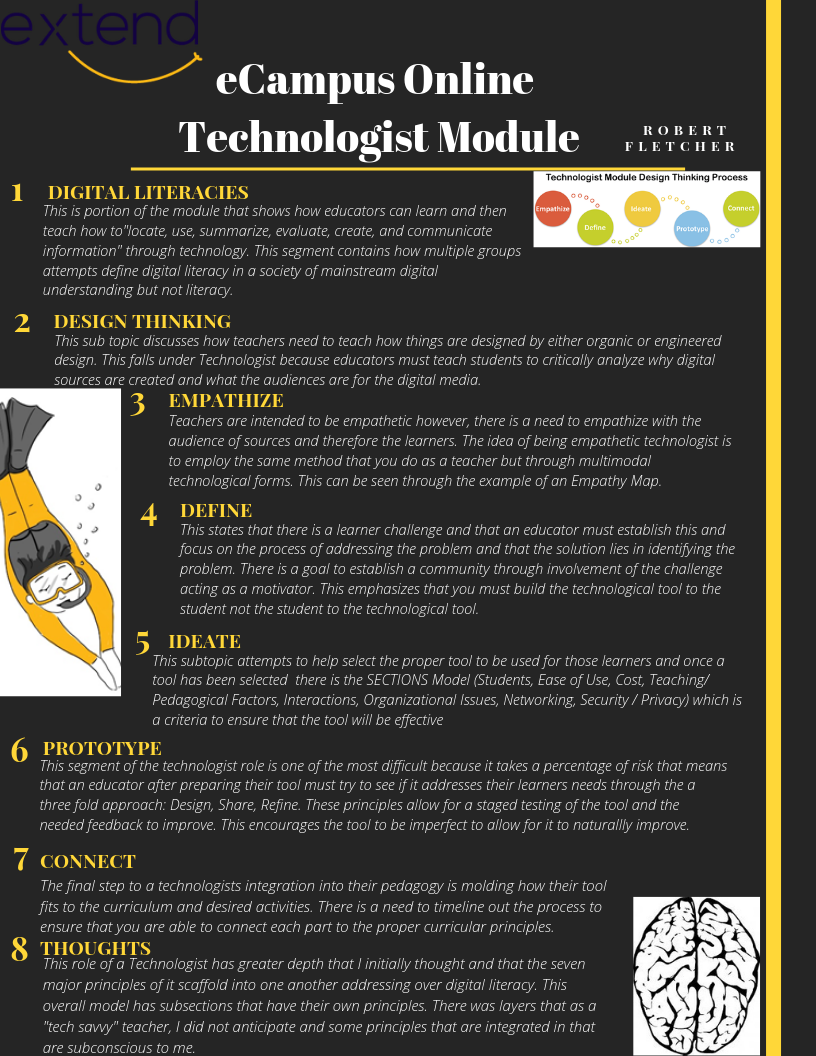 Going through the role of the technologist on the eCampus modules proved to be an eye opening experience with it showing me how much that is taken for granted as an educator who was raised into a technology the skills that I employ naturally, but a majority of teachers would not. There is a natural effort throughout our lesson planning to integrate technology into the classroom so that it is relevant to the audience, therefore aligning it with curriculum. However, the one concept that I found that I commonly skip or overlook is the prototype stage, where I learned that I tend to just risk it but not form a controlled risk or have a segmented release of the tool. This made me self reflective of the tools that I do use in my lessons and it made me realize that there is many different tools that I use but they fit the same mold . That mold is traditional education through quizzes or testing of knowledge, such as kahoot or mentimeter. This made me critically reflect on the fact that I may use technology in the classroom but it might not be fully addressing the challenges of the learners which is the end goal for integrating technology. I understand that there may be a use of technology in the classroom but it may not be effective. The role of the technologist has so many steps and subtle nuances to ensure that when you as an educator employ differentiated instruction that it not only understands the class problems but properly addresses them. Furthermore, we always learn about student centered learning as a core concept to most teacher pedagogues, however I learned that you need to select the tool for the student not the technological tool that the teacher enjoys. The overall module for technologist was effective because it mirrored what it sought to enforce by providing multimodal education with it having facets that appealed to multiple different types of intelligence by utilizing textual, visual, auditory, and linguistic elements to reach the audience. this is effective while at the end it models further strong educational skills by emphasizing the value of feedback to improve its modules, while recognizing the fact the facing constructive criticism is one of the hardest parts of integrating a new tool into the classroom. This module had a far greater depth than I had anticipated which is the reasoning for why I chose to do an Infographic because there was far too much information to express with a more visually driven platform such as Powtoon.
Going through the role of the technologist on the eCampus modules proved to be an eye opening experience with it showing me how much that is taken for granted as an educator who was raised into a technology the skills that I employ naturally, but a majority of teachers would not. There is a natural effort throughout our lesson planning to integrate technology into the classroom so that it is relevant to the audience, therefore aligning it with curriculum. However, the one concept that I found that I commonly skip or overlook is the prototype stage, where I learned that I tend to just risk it but not form a controlled risk or have a segmented release of the tool. This made me self reflective of the tools that I do use in my lessons and it made me realize that there is many different tools that I use but they fit the same mold . That mold is traditional education through quizzes or testing of knowledge, such as kahoot or mentimeter. This made me critically reflect on the fact that I may use technology in the classroom but it might not be fully addressing the challenges of the learners which is the end goal for integrating technology. I understand that there may be a use of technology in the classroom but it may not be effective. The role of the technologist has so many steps and subtle nuances to ensure that when you as an educator employ differentiated instruction that it not only understands the class problems but properly addresses them. Furthermore, we always learn about student centered learning as a core concept to most teacher pedagogues, however I learned that you need to select the tool for the student not the technological tool that the teacher enjoys. The overall module for technologist was effective because it mirrored what it sought to enforce by providing multimodal education with it having facets that appealed to multiple different types of intelligence by utilizing textual, visual, auditory, and linguistic elements to reach the audience. this is effective while at the end it models further strong educational skills by emphasizing the value of feedback to improve its modules, while recognizing the fact the facing constructive criticism is one of the hardest parts of integrating a new tool into the classroom. This module had a far greater depth than I had anticipated which is the reasoning for why I chose to do an Infographic because there was far too much information to express with a more visually driven platform such as Powtoon.
